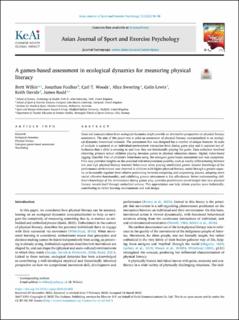| dc.contributor.author | Wilkie, Brett | |
| dc.contributor.author | Foulkes, Jonathan | |
| dc.contributor.author | Woods, Carl T. | |
| dc.contributor.author | Sweeting, Alice | |
| dc.contributor.author | Lewis, Colin | |
| dc.contributor.author | Davids, Keith | |
| dc.contributor.author | Rudd, James | |
| dc.date.accessioned | 2023-03-02T14:28:55Z | |
| dc.date.available | 2023-03-02T14:28:55Z | |
| dc.date.created | 2022-05-18T10:39:35Z | |
| dc.date.issued | 2022 | |
| dc.identifier.citation | Asian Journal of Sport and Exercise Psychology. 2022, 2(1), Side 50-58. | en_US |
| dc.identifier.issn | 2667-2391 | |
| dc.identifier.uri | https://hdl.handle.net/11250/3055486 | |
| dc.description | This is an open access article under the CC BY-NC-ND license (http://creativecommons.org/licenses/by-nc-nd/4.0/). | en_US |
| dc.description.abstract | Ideas and concepts taken from ecological dynamics might provide an alternative perspective on physical literacy assessment. The aim of this paper was to pilot an assessment of physical literacy conceptualised in an ecological dynamics theoretical rationale. The assessment that was designed has a number of unique features: its scale of analysis is captured at an individual-environment interaction level during game play and it captures key affordances that a child is attuning to and how they are functionally playing the game. Data collection involved observing primary school children playing invasion games in physical education classes. Digital, video-based tagging (Dartfish Pro) of children's behaviours using the emergent game-based assessment tool was completed. Pilot data provided insights on the potential rich interpretations possible, such as readily differentiating between low and high physical literacy learners’ behaviours when playing small-sided games. Greater knowledge of the performance environment was observed in children with higher physical literacy, noted through a greater capacity to favourably regulate their relative positioning between competing and cooperating players, adopting more varied offensive functionality, and exhibiting greater attunement to key affordances. Better understanding children's knowledge of the environment during games play, provides practitioners novel insight into how physical literacy reveals itself through embedded actions. This appreciation can help inform practice more holistically, contributing to richer learning environments and task design. | en_US |
| dc.language.iso | eng | en_US |
| dc.subject | ecological dynamics | en_US |
| dc.subject | emergent games-based assessment | en_US |
| dc.subject | physical literacy | en_US |
| dc.subject | wayfinding | en_US |
| dc.title | A games-based assessment in ecological dynamics for measuring physical literacy | en_US |
| dc.type | Peer reviewed | en_US |
| dc.type | Journal article | en_US |
| dc.description.version | publishedVersion | en_US |
| dc.rights.holder | © 2022 The Authors | en_US |
| dc.source.pagenumber | 50-58 | en_US |
| dc.source.volume | 2 | en_US |
| dc.source.journal | Asian Journal of Sport and Exercise Psychology | en_US |
| dc.source.issue | 1 | en_US |
| dc.identifier.doi | 10.1016/j.ajsep.2022.03.002 | |
| dc.identifier.cristin | 2025079 | |
| dc.description.localcode | Institutt for lærerutdanning og friluftslivsstudier / Department of Teacher Education and Outdoor Studies | en_US |
| cristin.ispublished | true | |
| cristin.fulltext | original | |
| cristin.qualitycode | 1 | |
